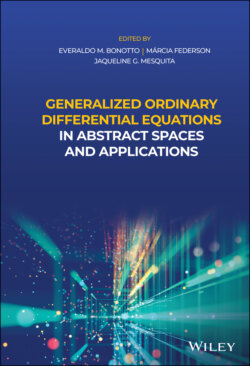Читать книгу Generalized Ordinary Differential Equations in Abstract Spaces and Applications - Группа авторов - Страница 17
1.1.4 Relatively Compact Sets
ОглавлениеIn this subsection, we investigate an extension of the Arzelà–Ascoli theorem for regulated functions taking values in a general Banach space with norm .
Unlike the finite dimensional case, when we consider functions taking values in , the relatively compactness of a set does not come out as a consequence of the equiregulatedness of the set and the boundedness of the set , for each . In the following lines, we present an example, borrowed from [177] which illustrates this fact.
Example 1.17: Let be bounded. Suppose not relatively compact in . Thus, given an arbitrary , there is a sequence of functions in for which
for all and for some constant . Hence, the set
is bounded, once is bounded. Moreover, is equiregulated and is relatively compact in . On the other hand, is not relatively compact in .
At this point, it is important to say that, in order to guarantee that a set is relatively compact, one needs an additional condition. It is clear that, if one assumes that, for each , the set is relatively compact in , then becomes relatively compact in . This is precisely what the next result says, and we refer to it as the Arzelà–Ascoli theorem for Banach space‐valued regulated functions. Such important result can be found in [97] and [177] as well.
Theorem 1.18: Suppose is equiregulated and, for every , is relatively compact in . Then, is relatively compact in .
Proof. Take a sequence of functions . The set is equiregulated by hypothesis. Then, for every , there exists a division fulfilling
for every and , .
On the other hand, the sets and are relatively compact in for every , where . Thus, there is a subsequence of indexes , with , for which and are also relatively compact sets of , for every .
This last statement implies that there exist and satisfying
Thus, there exists such that
provided . In particular, for , we have
for .
Take and consider such that . Therefore, either , for some , in which case, we have
or , for some , in which case, we have
Hence, for every , satisfies the Cauchy condition. Due to the fact that is a complete space and because is a Cauchy sequence, the limit exists.
We conclude by considering Then, on , by Lemma 1.13. Hence, is the uniform limit of the subsequence in . Finally, any sequence admits a converging subsequence which, in turn, implies that is a relatively compact set, and the proof is finished.
We end this subsection by mentioning an Arzelà–Ascoli‐type theorem for regulated functions taking values in . A slightly different version of it can be found in [96].
Corollary 1.19: The following conditions are equivalent:
1 a set is relatively compact;
2 the set is bounded, and there are an increasing continuous function , with , and a nondecreasing function such that, for every ,for
3 is equiregulated, and for every , the set is bounded.
We point out in [96, Theorem 2.17], item (ii), it is required that is an increasing function. However, it is not difficult to see that if is a nondecreasing function, then taking yields is an increasing function. Therefore, Corollary 1.19 follows as an immediate consequence of [96, Theorem 2.17].
